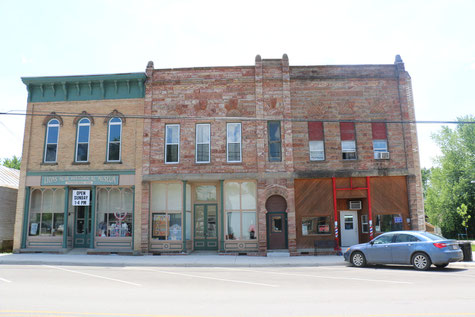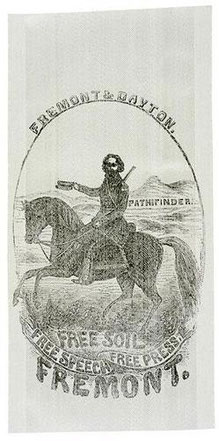1856
September 1, 1856 - The Beginning
Rosette Cordelia Ramsdell Journal No. 14 1856
Lyons, Ionia Co. Mich.
Sept.
Then I went to Mr. Crampton’s, I engaged him to varnish my maps. & as I wished to attend the Teacher’s’ Institute, I, after calling on Mrs. Loyed went to Mrs. Hall’s to see Miss Gower, the principal of the Union school here. I was told to go to the Pacific Hotel, & she would see me there. I accordingly directed my steps thither I found several ladies in the sitting room, on the same errand as myself. I learned the names of some. Miss Newman, Miss Thomas, Miss Grey, Miss Babcock, & Miss Cold, a sister of Sarah C. who I saw last winter at Mr. Lee Pattey’s
_____
This is the opening entry of Rosette's journal, after a few notes on the end papers. It is typical of the cataloging throughout the journal, offering names that sometimes appear again and sometimes do not. She notes "Lyons" because she is there for the Institute, though she lives about seven miles southwest, in Orange Township. Note that this is her fourteenth journal - how young did she start?

I do not know the dates for this group of buildings in what is today tiny Lyons, Michigan. At the left is the Lyons-Muir Historical Museum. A later entry in Rosette's journal tells of several stores in this town burning down, though the owners were insured for $1000 each.
September 2-6, 1856 - The Teachers' Institute
Tuesday 2nd. . . . Order of exercises for the day. 1st Grammar, 2nd Composition, 3rd Government. Lecture in the evening on American Taste, and it was excellent. Proffesser [Welch] directs us to write an essay to be read at our last meeting. And what shall poor me do. I never wrote a composition in my life. But I suppose I must try, nolens volens [whether willing or unwilling]. . . . The motto of the Union School here is, We aim to excel.
Wednesday 3rd. Order of exercises. Grammar, singing taught by E. Daily, & general discussions on the mode of teaching. Father was there & took part in speaking. . . . Mrs A. has nine canaries.
Thursday 4th. The exercises were grammar, reading, & singing. . . . Discussion in the evening.
Friday 5th. Exercises of the day were reading, grammar, music, & arithmetic by Mr. Gracy of Ohio. Proffesser Mayhew
arrived in the afternoon, & delivered a lecture in the evening, to a large audience, on Education, generally & specially.
Saturday 6th. Rained in the night. . . . We had our attention directed in the forenoon to Grammar, mode of managing schools &c. & in the afternoon to Music, reading & arithmetic. Proffers Welch & Mayhew, have gone home, & two more gentlemen have come. One is Gregory & the other’s name I did not learn. I am reading Alone. There has been 49 teachers attending the institute so far. . . . Went to hear a lecture delivered by Mr. Gregory. He took a list, which he thought was to be found somewhere in Psalms. It was this as nearly as I can recollect. Children are an inheritance of Heaven. It was very good.
_____
This agenda of a week-long Teachers' Institute gives a glimpse into educational practices of the day. Rosette's father
Jacob Ramsdell was a supervisor of schools in their area and well-respected as a mathematician. He had formed the plan for
the layout of streets in Kalamazoo when they lived there in earlier years. Read more about Jacob and about Rosette's distinguished brother Solomon here:
The City of Grand Rapids and Kent County, Mich., Up to Date, Containing Biographical Sketches of Prominent and Representative Citizens, Illustrated (1900) .
Professor Gregory mentioned here is John Milton Gregory, at that time the founder of a classics school in the Detroit area and later president of the University of Illinois, and an advocate for the education of women. His book The Seven Laws of Teaching is a classic on the subject, still popular especially in the classical education movement.
At this time Rosette was 26 years old and had been teaching school for years, and later entries refer to students in a school reading their compositions. Isn't it curious that she has not, at this time, ever written a composition herself? I would note, though, that her journal, the fourteenth of her life, is about 22,000 words, some passages quite lyrical. Her language in this section is more hurried, with more errors, typical of jotting things down at the end of busy days in town, boarding in a strange home, with much lecture material in mind.
October 14, 1856 - Abolitionist Campaign
Tuesday 14th. . . . Father, mother & Sol went to Ionia to a Republican mass
meeting. They had a great meeting. They thought there were about three thousand people. They had badges to wear, which consisted of white watered ribbon & red satin to, 10 inches long, with
first at the top an eagle, then Freemont & Dayton, then the portrait of Freemont, then, free speech & free men, then Slavery shall not travel into Kansas by our votes. Thirty-two ladies,
representing the states went from Lyons. The one representing Kansas wore a black cape.
_____
The presidential election of 1856 saw sharp divisions among the American people. Rosette records her family's alignment with the new Republican party, which nominated John C. Frémont as candidate. He won 1.3 million votes, ultimately, but only 1200 votes in slave states, and Democrat James Buchanan defeated him with 1.8 million votes. Frémont was not deterred from politics, though, and ran on the "Radical Democracy Party" ticket against Abraham Lincoln in 1864.
In 1856, though, Frémont enjoyed the support
of lawyer Abraham Lincoln in the only political campaign speech Lincoln ever made in Michigan--in Kalamazoo August 27, just a few days before
Rosette's journal opens. Did Rosette's father Jacob or her brother Solomon, both of whom voted with the abolitionist Republican party, hear that speech? It is interesting that the Kalamazoo
attorney who invited Lincoln was also the previous (investment) owner of Jacob Ramsdell's farm in Ionia County. They may well have been acquainted, if not friends, when the Ramsdells lived in
Kalamazoo the previous decade. Jacob Ramsdell was a prominent early citizen of that city--he laid out the plan of its
streets and was elected county judge before moving to Ionia County in 1845.
The journal recounts a couple of political meetings beyond this one in Ionia County, and in one Jacob Ramsdell made a speech in lieu of the no-show speaker, and was with another man elected delegate to the county convention. One nearby county was so thoroughly in harmony with the abolition sentiment that 90% of its men voted for Frémont. This 1856 election was important enough to Solomon that it is mentioned in his 1900 biography in The City of Grand Rapids and Kent County, Michigan.
For a fascinating additional note about campaigns and fashion, something Rosette might well have been excited about, given her
loving detail of the "badges" from the mass meeting, please subscribe to
the email list.
October 21, 1856 - School Dreams
Tuesday 21st. . . . I dreamed that I took a school, the first day arrived. I entered the
house & there were young men & women. I called them to order and asked them round what readers they used, & they told me the names, I can not remember one of them now, but there were
hardly two alike in the whole school. They commenced reading & one girl 13 or 14 years old made some trouble & I talked to her, but it did no good, she was just as bad two minutes after
& the rest of the scholars I found to be pretty fractious generally. I had a great deal of trouble that day.
_____
If you've ever taught school--or been in school, for that matter!--you know the fears that can creep into our dreams as we
anticipate a new school year starting. Rosette's dream here could just as well be my dream, or yours--students and teachers and schools have much in common generation after generation. Socrates
said millennia ago, "The children now love luxury. They have bad manners, contempt for authority; they show disrespect for elders and love chatter in place of exercise." (Quoted on GoodReads here)
When I visited Ionia County, Michigan in June 2015 I was privileged to meet Ford Wright, who grew up on a farm just a mile or
two from Rosette's, and who is a careful, detailed historian of the area. He gave me several maps and other documents, one of which is his retyped version of a presentation made at a local
Pioneer Day Celebration of Orange Township in 1940. Ford Wright has kindly given me permission to share this history of the local schoolhouse that Rosette's family was associated with, and I
worked some of the details into the novel. I reproduce most of one section below, because it is not elsewhere published and may be of interest to many who might not otherwise be able to access
it.
The King School District (1841-1863). The records show David King, Adam Lewis, and John Brown were the first school officers. From David King and his sons, Myron and Arza, the district received its first name--the King district. That was the name by which it was [known] for the first twenty-five years. the Kings deserved the honor: they were the largest land holders, having in all 242 acres all situated at or near what is now known as Rikers Corner.* They were public spirited, and interested in district and township affairs. . . .
. . . In 1845 Orange township was organized, [and the school district became] District No. 1 Orange township until 1872, a period of 27 years.
In those pioneer days it is interesting to know but three months of school was held in a year . . [and] later six months of school was provided, and that the summer term of three months continued through the months of July and August. Teachers' contracts at first bound the teacher to teach 6 days per week; later 5-1/2 days were specified. Then there was the rate bill whereby parents paid a certain sum for each child sent to school. At first fifty-cents per child was required, later increasing to $1.00 per child. Then it was changed so parents paid according to the number of days their children attended in a year. A strange requirement was at first every family had to provide one-half cord of wood and deliver it to the school, increasing until later each family delivered one cord to the school premises.
The requirement that teachers board around was another strange requirement. Imagine the discomforts of those teachers when most of the houses were dog houses [shanties] and seldom had room to spare, and think of the different conditions of those homes. It was reported back in those days one woman said to another, "Thank the Lord I've got all my dirty work done--beef killed, hogs butchered, soft soap made, and teacher boarded." Then think of the salary paid--first $1.00 per week of 6 days; then $1.25, $1.50, $1.75. Finally we read in a school meeting report, "Resolved: That we hire a first class man teacher." Evidently they succeeded in getting one, for the teacher they got received the princely salary of $3.00 per week.**
A few years ago I had the pleasure of hearing an old gentleman relate pioneer experiences and remembrances of school days. He would always chuckle when he told about a certain lady teacher who at recess and noons proceeded to fill her clay pipe with good tobacco and quiet her nerves with a good smoke. In looking over records of 85 and 90 years, I found the name of this teacher signed to a contract to teach in this district. It is only reasonable to presume that the boys and girls of our district at intermissions also had the pleasure of inhaling the aroma of sweet burley or banner tobacco.
The Second Schoolhouse (1855). [The one Rosette describes in her journal in 1856] The year 1855 is an important date in the history of the district. Then a new schoolhouse was built, and upon a different site [on the west side of Sunfield Road, south of the David Highway]. It was this event which brought to the front a very competent and energetic pioneer, Samuel Badger. In the first year of Orange township he was placed on the school board, and he was a man of many interests. He owned an 80-acre farm . . . and built the first sawmill in the township there in 1848. He was a good carpenter, so much so that he was selected to work on a Capitol building in Lansing. So when a new school building was decided upon, all eyes were turned towards Samuel Badger. The records show that at a district meeting it was decided to levy a tax to the astonishing sum of $2.00 to pay Mr. Badger for drawing complete plans of the proposed schoolhouse. . . . Then the contract to build was given to Mr. Badger; undoubtedly most of the timbers and lumber was sawed in his own mill [on the Libhart].
The plans called for a large building, because the district was the largest and most populated in the township. From township records we discovered that the district had 82 children of school age, and that in a few years following the average daily attendance was 56, so the enrollment at times must have been 65. . . .
This building was unpainted and simple in appearance on the outside, but the inside was very unusual. Never have I seen, and I doubt if you or anyone else ever saw, a schoolhouse planned like
this one on the inside. Those of you who are familiar with ancient history will get a mental picture of it if your imagination goes back 2000 years to the amphitheaters of the Greeks and Romans.
The teacher's desk was on a platform at the west end, about 8 inches high. On either side were 3 or 4 rows of seats, each row being about 8 inches higher than the one in front of it. The same was
true of the east end. Pupils on the south side faced north, those on the north side faced south, those on the east end faced west, and the teacher faced east. As every seat was 8 inches higher
than the one in front, there was no hiding behind books. One glance of the teacher and he would spot you every time chewing gum or eating an apple. All back seats were at least two feet higher
than the floor level in the center of the room.
I have heard my mother say more than once, that in the early days that schoolhouse was considered a wonderful one, and that people came long distances just to see it. But whatever it may have been, to the writer the memories of it are sweet, tender, happy and joyous. I believe it was my grandfather, the Rev. William Price, who introduced a resolution in the annual meeting which provided that the schoolhouse should be opened to any and all organizations that tended to increase knowledge or morality of the community. This was adopted, and henceforth the building became a community center. Here was held spelling bees, singing schools, writing schools, lyceums, stereopticon, ventriloquist shows, Sabbath schools, preaching services, etc. Further the Township of Orange used it to hold general elections and township meetings, and there is a record of the township paying the district $5.00 for such meetings.
---George L. Jordan, unpublished manuscript "History of the Riker School District No. 9, Orange," Ionia County, Michigan, 1940, used by permission of Ford Wright, who retyped it in 1989
*Riker swapped farms with King in 1863 and the Kings moved to Vergennes Township to the west, north of Lowell.
**I do not know whether it is the teacher referred to here, but the December 1856 journal refers to a Charles Lewis being "inspected, which was done & a certificate given him. He is from the state of N.Y. near where Otis lived, & is teaching in Mr. H's district." Years later this same Charles Lewis married Rosette's younger sister Ellen.
Use the link in the footer of this page to sign up for email updates and learn about
another crazy school dream Rosette had.
About Us
Cindy Rinaman Marsch, the author of Rosette, operates Moraine's Edge Books with editing and other services
A production of
154 Dight Road
Slippery Rock, PA 16057
Tel: (724) 738-9198





